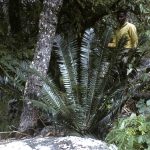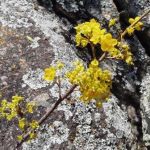TREE LIFE
DECEMBER 1992
MASHONALAND CALENDAR
Tuesday, 1st December: Botanic Garden walk at 4.45 for 5 pm. Park at the Herbarium where we will meet Tom Muller.
Sunday 13th December: This year we are holding our December outing and Christmas social at the Mukuvisi Woodlands. A fire will be lit so bring your steak and wors for a lunch time braai if you wish.
Entrance for members of the Mukuvisi Woodlands Association is free with membership cards, whilst the rest of us must pay $4 each. We’ll meet at the Woodlands main entrance at 10 am for a leisurely day.
December 25th : The Chairman and members of the committees of Harare and Bulawayo wish all members a happy and peaceful Christmas, and the country a really good rainy season. –
Tuesday 5th January : Botanic Garden Walk
EASTER 1993 – APRIL 9TH -12TH : Happily we have been able to reserve accommodation for – 22 people over the Easter week-end, at Ezulwini Holiday Farm Cottages in the Troutbeck area of Nyanga. Guests will only be required to bring their food, drink and perishable such as dishwasher liquid, toilet paper, and matches etc. The charges are $25 per person per night and as this will be a popular trip reservations will be on a first come basis. Please phone Ian McCausland on 41945, Bulawayo or Maureen Silva—Jones on 739711 Harare to book.
MATABELELAND BRANCH
Sunday 6th December : Visit to Peter and Jenny Parsons farm and their new safari camp “Ntabazinduna Lodge.” We will be doing a tree survey for them. It’s a morning outing so bring tea and chairs. Rendezvous at the City Hall car park for an 0830 hour departure and a trip which promises trees, game and spectacular views.
Monday 14th December : The Urban Trail at Hillside Dams at 4.45 for 5 pm.
Friday 1st January 1993 : Our usual New Years Day bash. Clem von Vliet has very kindly agreed to open her home to us for our traditional bring and share lunch. Afterwards if we have enough energy we can do some suburban treeing.
MATABELELAND BRANCH 1st November, 1992 – Matopos
Our first stop was at Rhodes‘ Summer House at the Rhodes/Matopos Research Station where the gun carriage was housed overnight en route to the Matopos. Geoff gave us some of the historical background including the fact that the carriage was drawn by mules to that point and from there on by oxen over a newly-cut track.
The upright timbers of the summer house (Rhodes‘ dining room) appear to be the original rough-hewn tree trunks, though the roofing timbers could well be replaced. We had a quick look at the stables which are beautifully built in brick and stonework and are in good state apart from some of the time on the outside staircase and parts of the doors.
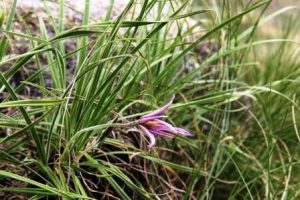
Xerophyta villosa. Photo: Bart Wursten. Source: Flora of Zimbabwe
The next stop was Lower Outspan where we parked and walked up the gun carriage route, much of which is over bare rock, with patches of Myrothamnus flabellifolius (some green after the rain), Anacampseros rhodesica and the traditional pot scourer, Xerophyta villosa. Within the car park area we paused to look at Allophylus africanus,
Homalium dentatum Mimusops zeyheri, numerous Olea europaea sub africana, Pittosporum viridiflorum, Pterocarpus angolensis and P. rotundifolius
Tarenna zimbabwensis and Vepris reflexa. Sharon led us off to an Acacia sieberiana and Ian showed us a good specimen of Artabotrys brachypetalus in bud, the woody hooked tendrils much in evidence plus numerous galls. Growing next to it was an Afzelia quanzensis. A Pseudolachnostylis maprouneifolia in new leaf attracted attention and also looking very pretty in new leaf were several Albizia tanganyicensis. On the walk down we deviated slightly to see an Apodytes dimidiata, close to which were growing Strychnos matopensis, Psydrax livida, Ficus natalensis, Maytenus heterophylla subs Puberula and very dry Heteropyxis dehniae.
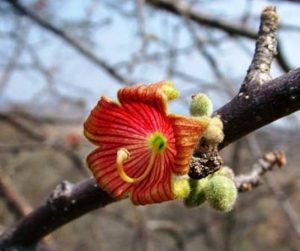
Sterculia rogersii,. Photo: Alan Gardiner. Source: Flora of Zimbabwe
After lunch we drove to Whitewaters and along the ‘Ringing Rocks‘ road as far as the less rugged vehicles could comfortably travel. We then walked to the view point which gave us a panoramic view of the Maleme valley and across the range of the Matopo Hills from Nungu to Shumbashala. Additions to the tree card included Dalbergia melanoxylon in full flower as were several of the Protea gaguedi and Albizia versicolor. One Dichrostachys cinerea was just beginning to bloom. A very exciting find was a Sterculia rogersii, a fine mature specimen.
On our drive through the park we saw Mundulea sericea in full bloom and Securidaca longipedunculata still blooming, but past its peak. An added bonus came in the form of good game viewing. We saw two herds of wildebeest, several groups of impala, two reedbuck, dassies, warthog, sable, baboon, monkeys, klipspringer, water-buck and a bushbuck. The weather was considerably cooler than of late which contributed to the overall enjoyment of the day. In all, some 82 species were recorded.
-MARGARET McCAUSLAND
BOTANIC GARDEN WALK : 3 NOVEMBER 1992
A welcome visitor at the Botanic Garden Wall: on Tuesday the 3rd of November was Kim, back on a short visit to Zimbabwe after 6 months in Norway. As on the previous walk, there was no prearranged plan – we simply looked at what there was and especially the species which were in flower.
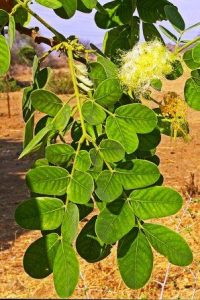
Albizia versicolor. Photo: Meg Coates Palgrave. Source: Flora of Zimbabwe
One of the points brought out during the walk was what fine garden subjects some of our native trees make. For example, we looked at Albizia versicolor. This was a beautiful tree, covered in creamy white flowers, with wonderfully soft leaves. Another species, this time in the forest section, was Tabernaemontana ventricosa. This does well in the Garden, reaching a size it would never attain in the wild and producing its white flowers for about a month. Tom remarked, however, that it requires plenty of water.
Near the Herbarium, we saw the Cape Chestnut, the striking Calodendrum capense, a pink-flowered tree from the family RUTACEAE. Incidentally, the rather peculiar, cluttered flower structure is caused by the presence of 5 staminodes (sterile stamens) which are larger than the petals and are dotted with crimson glands.
Once again, our thanks to Tom for giving us his time to act as our guide in the Botanic Gardens.
-Mark Hyde
FLORA OF HARARE AND CENTRAL ZIMBABWE
I am in the process of compiling information towards a Flora of Harare and Central Zimbabwe. Technically, the area to be covered is the Central Division used in Flora Zambesiaca, which includes Harare, Chegutu, Kwekwe, Gweru, Chivhu, Marondera and Rusape.
The purpose of the flora is to provide a means of naming the plant species which have been recorded in that area. It is intended to include all vascular plants but not ferns and fern allies. Approximately 2600 species occur, so it is a fairly daunting task.
There will be a number of (I hope) interesting tasks, which will include recording plants, searching; for specific species, testing keys and collecting plant specimens. In addition, there will be a fair amount of clerical work, such as compiling lists, extracting records etc.
If anyone is interested in helping with such a project (particularly if they can draw plants), please contact me for further details.
MARK HYDE, 29 Harry Pichanick: Drive, Alexandra Park, Harare.
Tel: 701023; (H), 793601 (w).
GOSHO PARK, 18th OCTOBER 1992
It promised even at 9.30 am, to be a hot day as a slightly smaller than usual party met at the picnic site for an introductory talk from Barry Percival, an art master at Peterhouse, whose special interest is the conservation of the park. The idea for the morning was to make our way to a viewpoint on top of one of the kopjes known as Bushman Point or the Boxing Gloves, and from there follow a set trail, identifying trees for Barry to label.
What a little gem of a place it is and although very dry indeed, there was much to see and the leaflessness of most species gave us ample opportunity for detective work, making us really look at barks and fruits and other identification points – very good for us!
The kopje lookout was interesting with two very large, roundish boulders only apparent as “boxing gloves” when looking back at them on leaving the park, Rob Burrett was with us and he added historical interest by suggesting that it was a late Shona refuge of the last 200 years and that grooves in the flat rock, that we had taken as grain grinding; marks were in fact caused by crushing ore for gold — this probably brought from Wedza.
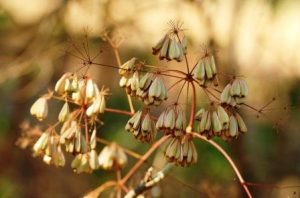
Steganotaenia araliaceae .Photo: Bart Wursten. Source: Flora of Zimbabwe
From the lookout we descended and with Phil Haxen leading began on the trees. The first specimen was a case where the bark helped identification. With its dried umbellifferous flower heads and no leaves to help, we had it as Steganotaenia araliacea (carrot tree), until Phil pointed out the bark; a beautiful, smooth deep brown red, with bamboo like nodes and a thin papery peel. We had, at least been in the right family APIACEAE with our first suggestion, but this was the parsnip tree. All round the slope as we moved down were numerous Diospyros whyteana, their green, shiny, hair fringed leaves very prominent among the surrounding dried out vegetation. There were old, dried Cape Gooseberry-like bladders still present, these being formed by the sepals which join and enclose the fruit remaining long after it has fallen. It has been an observation of ours on visiting farms, especially around Gweru during this dry time that the EBONACEAE family (Diospyros Sp. and Euclea sp.), CELASTRACEAE (eg. Maytenus sp.) and CAPARACEAE (eg. Boscia sp,) have been conspicuously green throughout – is it that they have mechanisms for withstanding heat and water shortage together with an unpalatability which prevents them from being browsed? A small fig had us debating as usual, Ficus thonningii or natalensis? In this instance, the former, the leaf not truncated enough to be F. natalensis and the central vein running all the way to the apex of the leaf. We found a F. natalensis later and this time there were no doubts as its leaves were very square across the top. A recently acquired “Trees of the Kruger National Park” differentiates the two on the exceptionally long petioles of F. thonningii – but members have not found this a help, nor the observation in Kim’s MORACEM key that the petioles of F. thonningii are of variable lengths on the same twig — we have not found this a consistent feature.
In the Tree Life notice for the outing we had been promised several trios of species. We saw Cussonia spicata – mainly dried out but a fresh new leaf was found showing the twice compound palmate structure. This is a species more normally seen in the Eastern Highlands and its presence here allowed us to compare its leaf with those of C. natalensis – a simple, palmate, deeply 5-lobed one and of C. arborea our more common highveld species usually compound with 5 or more separate leaflets. The second trio was of Protea species. All had leaves, so identification was simple; large blade, pink petioles = P. angolensis, narrow blade, velvety leaf = P. welwitschii, narrow blade, glabrous = gaguedi. This is a bit simplistic as there can be variations of hairiness, but it is a guide to be going on with, in this part of the country anyway.
In between collecting sets of three, we had a look (again but always useful) at the differences between Brachystegia spiciformis (msasas) and Julbernardia globiflora (munondo), both in full, fresh leaf. The msasa with fewer leaflets, has the largest at the end, waving in the slightest breeze making it Kim’s “friendly tree”. The munondo has more leaflets of which the largest are in the middle of the leaf. The pods of the munondo are velvety and grow usually in a halo over the tree, the msasas are smooth and borne among the leaves. From many of the Brachystegias old man’s beard (Usnea sp.) was growing in long strands, the eeriness this usually imparts dispelled by the fierce, bright sunlight, but its presence indicative, George said, of a winter mist belt.
A Garcinia buchananii definitely feeling the lack of water, could not be induced to show its yellow sap. In the woodland we found Apodytes dimidiata with wavy edged leaves and long, pink petioles and Diospyros lycioides identified on one dried out leaf and some star apples (this specimen had unusual spiry lateral spurs). I don’t think we found D. kirkii to make our third set of three, but I might be wrong. We did find three Erythrinas though E. abyssinica, E. latissima with larger leaflets and E. lysistemon like Cussonia spicata more common in the Eastern Highlands with much smaller, pointed leaflets, a smooth, non-corky bark and with its pods more strung out between the seed “bumps” than the other two.
Our lunch time, spent under a shady tree, was enlivened by the antics of a couple of Purple Crested Louries who were enticed into a noisy duet in the branches above us, determined to find the intruders they could hear from a recording of their calls played by Rob Burrett on his car tape player.
Many of the Party melted away (home!) after lunch and a much reduced number was left to explore further, finding, I am told, Olinia vanguerioides, in close proximity to another Apodytes dimidiata, quite a common pairing. Near some cave paintings another find was Phytolacca dodecandra , a creeper/straggler which is being investigated for its anti-bilharzia qualities. Schrebera alata was found by Dick Petheram, pleasing this, as it had not been previously listed as being found at Gosho Park.
We must thank Peterhouse School and our guide for the day, Barry Percival, for a truly enjoyable day. How enthusiastic he and the other teachers who joined us are with this project and for future plans of making more trails – a river one, a vlei one etc. It would be lovely to see it again after a good rainy season.
The day and the parched land reminded Bob Burrett of the following poem by Arthur Shearly Cripps which he thought would be of interest. He asks could one interpret “the leaden fall of oranges” as referring to Strychnos species‘?
-F.D.
SPRING – WAITING FOR THE RAINS
The land is black with fires and bare
Ere the warm rushing of the rains,
Yet blood-dipt leaf and bloom declare
How sap runs high in forest veins.
Blue cup with sunrise – ruddied brink
Hast no drops yet for Earth to drink.
Copper and gold dance eastern trees,
As pipes the wind climbs the sun,
Hark I Leaden fall of oranges
See Branch – flow’rs from moon-silver spun!
God, when wilt press within thy cup
One wine-skin cloud for earth to sup. ..?
SUNDAY 13TH NOVEMBER : VISIT TO URONGA SOUTH FARM – A MORNING WITH THE BUTTERFLIES
Several years ago the RAPT Christmas Stamps portrayed a selection of butterflies and plants chosen to match their vivid colours, armed with reference books it was fascinating to study them. It was very easy to see the connection between the exquisite African porcelain butterfly (the African fig Map butterfly mentioned in Bob Pare‘s article looking exactly like translucent white porcelain and the delicate pink tinged flowers of the Bauhinia galpinii. The Charaxes featured largely in the stamps, perhaps because this lovely family of Nymphs (Nymphalidae) are brightly, or even brilliantly, coloured and the Bush charaxes with orange or orange-yellow markings picked up the lovely colours of the four-winged fruits of the Combretum paniculatum. The pale lemon yellow of the Mocker swallowtale (genus Papilio is absolutely matched with Sphendamnocarpus prurients which despite its long name is merely the shrublet commonly known as “canary nettle” found growing everywhere. The Emperor swallowtail was not featured as it might have been to show off its lovely long tails; this is the largest butterfly in the country. Nor was its cousin, the Citrus swallowtail, regarded unfortunately as a pest because the larvae feed on the leaves of citrus trees and can wreak considerable havoc in plantations. Blues were represented by the Blue spotted Charaxes and the Blue pansy (also a Nymph) sporting a large irridescent violet or blue discal spot on each hindwing, beautifully teamed with Thumbergia lancifolia . Was it a joke that the most unusual red-rimmed-flowers of the Adenium obesum (Sabi Star) were shown with the Joker (a Nymph) a common butterfly found throughout the year being dark orange with black terminal bars and discal spot.
These pretty stamps tell us nothing except show us the beauty of the butterflies so in anticipation and inspired by Rob’s article in last month’s Tree Life we arrived at the farm in the coolness of a slight drizzle looking forward to finding out a lot more. During a short introductory speech Rob explained that at an early age he had built up quite a good collection of butterflies and then decided there was a lot more to be found out than just collecting. Very little literature on butterflies existed, and so although much of his scientific observation is done in the field on indigenous plant species he decided to grow trees and plants and breed butterflies in a more protected environment (i.e. the larvae being protected in nets from spiders and birds). On an existing site several species of the more common indigenous trees were already established and so Rob began planting other indigenous trees in amongst them and close by in order to create a forest campy with plenty of shade and an under storey – and so the little forest was born.
Rob’s knowledge of indigenous trees now matches his knowledge of butterflies we discovered during our fascinating tour. Seed and plants have been collected from all over the country from the hot environment of the Zambezi Valley to the cooler climate of the Chirinda forest and a record of their survival and growth pattern and their attraction for what species of butterfly carefully recorded. A well established but young Mimusops zeyheri showed such differences as led to doubt in Rob’s mind as to its‘ true identity but on discussion it was decided that it was true to type (leaves with midrib prominent on both sides). Miniature praying mantises found on a branch were charming – hardly indicating the unpleasant cannibals they are to become. Another very interesting tree was a Syzygium cordatum, showing little evidence of the cordate shape and with thinner leaves; George felt it was a hybrid species growing in the Mazoe Valley area and this was later confirmed by specimens found growing along the Mazowe River banks where we were able to see a net covered branch of a Brachystegia boehmii with larvae and close by another net covering a fat baby caterpillar, sleeping, eating and whiling away the time, until it was time for it to pupate and then perhaps to wait another month for the time to emerge in all its glory as a butterfly.
Another was an interesting specimen found in the Vumba (a charaxes penricei) and this baby was her only egg. The fig was in fruit; was this the only food of the Fig Tree Blue (family LYCAENIDAE). Rob confirmed that any fig fruits were acceptable, even the cultivated ones. This lovely butterfly is a relative of a group of brilliant blue sapphire butterflies Iolaus of the same family; various species of Loranthus and Viscum are the food plants of this family and frequently distribution of this butterfly is restricted by the availability of these parasitic plants. The pupa of one species Iolaus seen closely resembles a germinating Loranthus seed – a most extraordinary case of protective mimicry. Asked how one could propogate Loranthus without the aid of a bird Rob showed how the sticky seed could be firmly stuck on to a tree (they are not too particular about their hosts) and it will germinate there.
Mimicry plays a significant part in the lives of butterflies, especially amongst the Lycaendidae, and here the family Danaidae, the Monarchs or Milkweeds, act as models. Monarchs have tough bodies which contain acrid juices, thereby rendering them unpalatable to birds and other predators – many a bird breakfast of a more tasty species has been forsaken because of this ruse. Their main food plant is of course milkweed (Glossostelma carsonii) and this is to be found in Brachystegia woodland and often on rocky hillsides. During the summer this plant is easily recognised by its small (only about 2 cm) dark maroon flowers, and it contains a white sap relished by the Danaidae. There is but one totally indigenous species of butterfly in Zimbabwe – and this is a Charaxes named after a Mr Gallagher, i.e. Charaxes gallagherii.
There was so much more of interest in the little forest, but by now it was getting hot and tea and cream scones lured us away in dribs and drabs to the shade of the trees at the farm house. There during tea we were able to study once more the collection of butterflies and see how clever they really are in the art of mimicry and in their survival tactics. For instance, take the little African migrant (family Pieridae) which feeds on Senna singueana and when food scarce flies off many hundreds of kilometres to the Southwest to return later when food becomes plentiful again. Have we not all seen them in their hundreds sucking at damp sand or congregating on flowers? Thank you, Rob – your article and our subsequent visit have, added a new dimension to our tree excursions no longer will this be a “rare and gentle thing” be regarded merely as such, but a friend indeed in the identification of our tree species.
It was most opportune that this month the Post Office have issued the Butterfly stamps and so at the end of the day it was with pleasure that we were able to present Rob with a first day cover.
-VdeVSiebert .
POKUNWANDA
Having left the Pare’s a cavalcade of vehicles entered Garth Snook’s Pokunwanda game reserve causing much interest to passing pedestrians. Once at the car park a small number of vehicles with “unrugged” persons headed for the riverine stop. The “rugged” set walked to the lunch spot – a hot but interesting walk.
Extremely corky-barked Ormocarpum kirkii was seen along the road as was some large spectacular red “leafed” Brachystegia boehmii lighting up their corner in drought brown bush. A snaky Adenia gummifera wound its way into the branches of a large Acacia goetzei close to a grove of Bolusanthus speciosa. This provided a moment to mop a hot brow, within some shade. Tiny 3 foliate leaflets and some spines made this Commiphora africana easy to identify.
Once into the vicinity of the Mazoe river, lunch was eaten causing a Hamnerkop some anxious moments whilst she/he checked out the humanity below on the rocks. Peering at us from her cobweb nest which she’d built on to the underneath of the Hammerkops’ nest was a sunbird, and Bob, every ready with his binoculars noticed a crocodile half submerged upriver.
After lunch a ramble along the river produced many hideously spined Flacourtia indica like some arboreal man ‘0 ‘war. Typical Albizia flowers scattered about the ground gave the game away for an A. versicolor. This part of the Mazoe was definitely a ‘Kigelia Place’ with masses of sausage like fruits lying all over the area. Judging by the number collected, the Haxens should have vast numbers of K. africana in their garden.
An odd pod on an average tree caused little interest but Maureen assures me that it belongs to an Afzelia quanzensis! Another treat of the day was an enormous Dalbergia melanoxylon with a few leaves, growing on the river bank.
Catching a ride back to the car park on Garth’s bakkie was a great idea as close to the car park were five superb giraffe were seen and to complete the afternoon a flock of crowned guinea fowl provided a sort of outrider duty until they flew of flapping heavily into the bush.
To Garth and Rose, very many thanks indeed for a superb time at Pokunwanda.
-Babe in the wood.
NYARUPINDA CATCHMENT November 1992.
The Scene It is November, the water measure mast in the Nyarupirnda dam is dry yet there is a huge barbel which teases the fishermen. Strong winds blow nearly every day and keep the rain away. Many trees are dormant. There is ‘a full moon latticed by twigs and serenaded by cicadas,
. . . . ‘Speak to me of a night so full of stars that trees light up like Christmas overhead, touching; the night with magic.’
These lines are from two poems by Phillippa Berlin
Life Around a Tree – Julbernardia globiflora
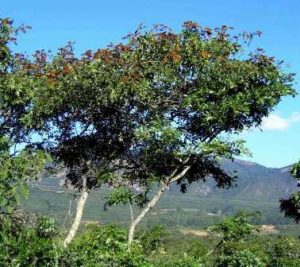
Jullbernardia globiflora. Photo: Bart Wursten. Source: Flora of Zimbabwe
The local name in the central area of Zimbabwe for Julbernardia globiflora is mnondo. This tree is widespread and is recognised by the white hair-fringed margins of pinnately compound leaves. Its clusters of flowers followed by dark brown velvety pods borne outside the foliage of the canopy are diagnostic.
In undisturbed woodland a mnondo casts speckled shade which allows the growth of grasses and herbs, this provides many species of animals with food and shelter. It is said that 148 species of trees and shrubs are browsed by kudu, this tree must surely be one of them.
In a garden situation the tree is briefly deciduous, hence its foliage provides a habitat for most of the year. A few minutes spent looking at mnondos show that a wide variety of living things are associated with their trunks and branches.
To begin with, look for plants growing on plants; lichens occur on the grey bark, lichens lack roots stems and leaves, their substance is composed of a fungus and a blue/green alga which live together for mutual benefit, their presence does not affect their host plant. Some twigs are covered with unsightly ‘pustules’ those are flowers of a parasitic plant which grows inside the branches and causes disfigurement and death of the twigs. The name of the parasite is Pilostyles aethiopica, it belongs to the same family as the largest flower in the world i.e. RAFFLESIACEAE, see “The Guinness Book of Records” and “Tree Life” No. 121 Root Note.
The semi-parasitic plant called ‘Matches’ have burgeoned this season in spite of water stress on their hosts. The ‘Matches’ growing in mnondo have pale greenish orange coloured flowers, this is a ‘stemmy’ rather than a leafy plant. Small grey-green leaves are clustered at well spaced nodes. This plant can photosynthesize but requires water and nutrient solutions from the tree. Its generic name has changed, lets‘ call it Topinanthes sp. This plant is important in the environment because its flowers contain nectar as do those of Julbernardia globiflora. The epiphytic orchid Aerengis verdickii is in bud, this specimen grows just out of reach on a branch which slants across the path to the stables, its flowering period will be noticed and enjoyed.
There are spiders whose webs are all shapes and sizes, most obvious are those at the ends of branches, leaves, twigs debris and captured prey are furled into a clump which juts out or hangs down. Other webs follow the contour of the bark at the foot of the tree to catch the travellers going up and down. Webs across holes are common place, they are not necessarily traps but a refuge for the spider. Once the rains begin arachnids become active and a greater variety will be seen, some are adept at disappearing whilst they are being observed.
Mnondo trees often look untidy, parts are defoliated by insects and their larvae and also by weaver birds. Rob Pare said that eleven species of butterflies are associated with this tree, but as they feed on a first come first served basis and none of their species is particularly common, they are probably not the cause of the destruction. The culprits may show themselves on young finely hairy leaflets on coppice growth of regenerating mnondo in Brachystegia woodland and where there is bush encroachment.
A storm blew down a mature tree which is in tight flower bud. Honey bees collect the nectar in summer
Julbernardias near the house struggle to grow because the soil is shallow and the site is windswept, almost every tree is damaged, holes, crevices, dead stumps of branches and hollow trunks, these are ideal places for lizards (in the widest sense i.e. geckos and agamas) to hide and seek for their livelihood. At other times they venture into the open to stand motionless waiting for ants, beetles or a grasshopper to come within range of their swift movements.
Holes in trees and in the ground are interesting; according to bush lore, flies visit those which are occupied, and cobwebs close the empty ones, standby for surprises, take nothing for granted. Snakes frequent the cool shade and find prey and shelter in holes.
The truth of the first-mentioned precept of bush lore was demonstrated last week (Nov. 2nd – 9th) when nestlings of a Yellow throated Sparrow were in a hole in a mnondo. Near the entrance, but out of sight from the front, was an agama, so still that its head resembled the stub of a dead branch. Flies settled near the rim of the hole. A bad smell came from the hole, this was puzzling, because there had been no activity at the nest for several hours. At last the feeding routine re-commenced, the youngsters popped up to call back to their parents and to be fed with insects gleaned from bark and foliage and from a gravel path. The nestlings were very much alive and had not come to any harm. The much used nest caused the smell. “Roberts‘ Birds of Southern Africa” states that the Yellow throated Sparrow feeds on nectar from Topinanthus and Aloes, the pale flowered species of the former on mnondo is in bloom now.
The woodpeckers mentioned in this letter in “Tree Life” No. 152, worked at a hole in a stately Julbernardia for about three days and never returned, something was wrong. Blue Waxbills build secure nests in the foliage – some are well hidden, whereas those of the Paradise Flycatcher are prominent and sometimes occupy a precarious place likely to be tossed about by gales, ‘down will come baby and cradle and all‘ .
These old trees provide homes for insects (moths, caterpillars, borers and bugs)and spiders for the Spotted Creeper, which frequents the garden its beautifully made nest has yet to be found – it is bound with spiders’ web and lined with plant down and soft cobwebs.
The Spotted Creeper favours the mnondo trees, some of which are in tightly closed flower bud at the moment.
As regards mammals living around these trees there is not much to say except that it is fortunate there are no squirrels which otherwise make a nuisance of themselves damaging thatched buildings. Lack of suitable food, the dogs and humankind keep them away. They can be heard chattering and scolding in woodland close to the house.
Some months ago during the cool Chirimo Forest Dormice came to the kitchen through the ventilator fan, they left their holes in the trees. Some of them came to a sad end in the electric cooker and this is the end of the story. There is an irresistible phrase about small mammals in temperate regions. Weaselly recognized and stoatally different! How can you tell them apart?
It looks as if the rain is coming today.
-Benidicta Graves.
HELP : After temping as treasurer for 7 years, Joy Killian has justifiably decided – enough, So with effect from 1st April there will be a vacancy on the committee for this post. While an accounting degree is not a requirement, accuracy in receipting subs obviously is important, and this can be a rather time consuming job at the beginning of our year. So if you have a little time to spare and would like to become involved please contact a committee member, or phone Joy on 308398 at home for more information we all thank Joy for so ably handling the financial affairs of the Society and for insuring that we are still afloat.
THE FOREST RESEARCH CENTRE in Highlands has reprinted “The Indigenous Timbers of Zimbabwe” by B. Goldsmith and D. Carter, originally published in 1981. This thorough and comprehensive study of the wood properties of 360 of our indigenous trees also includes brief descriptions of each species and over 1750 common and local names. It is available from the Research Centre – No. 1 Orange Grove Drive Highlands at the reasonable cost of $50.
FURTHER ON FIG
In April we again looked at the venerable Ficus sycomorus on Anne and Jim Sinclair’s farm Serui Source.
Naturally as always we discussed its possible age. After leaving it, from the back of the truck which lifted us down to below the dam wall, I counted four of its children nearby and I guessed their ages to be between ten and sixty years.
Not only we, are interested in old Figs, in both travel books and fiction, reference is often made to ancient figs. They are features of the landscape, make useful rendezvous points and can be invested with mystique; and in a well constructed plot (sometimes also in fact) may be relied upon to fall down in response to an appropriate culmination of factors.
Rarely, if ever do we get historical confirmation of the age of these ancient trees. So, as I know of one such tree, partially documented it is time to record it for posterity.
In March 1991 the City Parks Department felled a senile Ficus sur in central park, close to the corner of Park Lane and Selous Avenue. This tree was still fruiting when it was dropped. I had been watching it for over two decades. When I first saw it, it was as senile and with as many dead limbs as it was the day it was destroyed.
Now comes the documentation. In 1892 an artist sat on the south side of Samora Machel Avenue and painted the offices on the other side. These were the then seat of government and LS. Jamieson presided therein. The water colour thus created is hopefully still safe in National Archives.
There not being many buildings in Jameson Avenue at that time, to get perspective the artist was faced with an expanse of nothingness on the left hand side of his canvas, so he painted in the only background material there was, the above mentioned fig tree.
In this painting it looks exactly the same as when I first saw it in about 1970 and when it came down in 1991. I am going to be objective and not speculate an age; suffice to say here we have a record of a tree senile for a century and it was still fruiting when it fell.
-George Hall Chairman
A MERRY CHRISTMAS AND A PROSPEROUS NEW YEAR
GEORGE HALL CHAIRMAN


